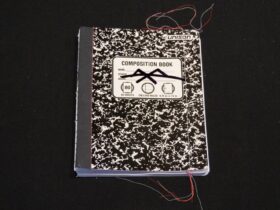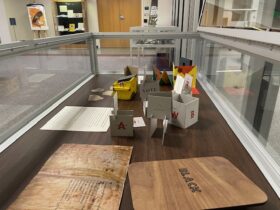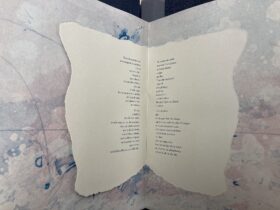The Ellesmere Chaucer is the October Book of the Month in honor of the Center for Medieval and Renaissance Studies’ (CEMERS) 50th Anniversary

The Ellesmere Chaucer reproduced in facsimile. Manchester : The University Press, 1911. Call number: Z 1152 .C496, v.1-2.
The Ellesmere Chaucer, or Ellesmere Manuscript of the Canterbury Tales, is an early 15th-century illuminated manuscript of Geoffrey Chaucer’s Canterbury Tales. It was first owned by John de Vere, 12th Earl of Oxford (1408–1462), but the manuscript takes its popular name from the fact that it later belonged to Sir Thomas Egerton (1540–1617), Baron Ellesmere and Viscount Brackley, who apparently obtained it from Roger North, 2nd Baron North (1530/31-1600). The library of manuscripts, known as the Bridgewater Library, remained at the Egerton house, Ashridge, Hertfordshire, until 1802 when it was removed to London. Francis Egerton, created Earl of Ellesmere in 1846, inherited the library, and it remained in the family until its sale to Henry Huntington by John Francis Granville Scrope Egerton (1872–1944), 4th Earl of Ellesmere. Huntington purchased the Bridgewater library privately in 1917 through Sotheby’s, and the Ellesmere Chaucer manuscript is now owned by the Huntington Library, in San Marino, California (EL 26 C 9). In addition to the Canterbury Tales, the manuscript contains a “balade” on the House of Vere (Earls of Oxford), by one Rotheley, in a later hand (1450-80); a Table of Contents, and Chaucer’s “Ballade of Truth” in a still different hand (before 1450); numerous signatures, marginal glosses, and many scribblings on the four fly-leaves at each end of the text.
The Ellesmere manuscript is a highly polished example of scribal workmanship, with a great deal of elaborate illumination and, notably, a series of illustrations of the various narrators of the Tales (including a famous one of Chaucer himself, mounted on a horse). As such, it was clearly a de luxe product, commissioned by a very wealthy patron. The manuscript is written on fine vellum and the leaves are approximately 400mm by 284mm in size; there are 240 leaves, of which 232 contain the text of the Tales.[2] Though the text was apparently copied by a single scribe, the illustrations were executed by perhaps as many as three artists.
The text of the Canterbury Tales in the Ellesmere manuscript is complete, in a large, clear book hand, covering 232 leaves of the finest quality thin vellum, sound and flexible. The page dimensions are noble, nearly 16 x 11 inches (the largest known manuscript of the Tales, Harley 7333, is about 18 x 13 inches), with unusually generous margins. But the main glory of the manuscript is the lavish illumination and illustration, in which the Ellesmere is easily unrivaled: on no less than seventy-one pages large foliated initials are joined to “demi-vinet” borders, in gold and other colors, framing the text on three sides. This “demi-vinet” is a conventionalized vine, the stem formed by a thick double bar, one of gold and one of color. This stem gives off, at intervals, rather stiffly curled branches bearing leaves, flowers, and hairline pen flourishes often tipped with gold balls — these last having something of the pleasant incongruity of our Christmas tree ornaments. On the whole, the design has an admirable suitability to the text it encloses: the thickness of the stem is balanced by the grace and delicacy of the hairlines, avoiding undue austerity on one side or decadent over-elaboration on the other. The text is supported by the border, not overwhelmed by it. Opposite the first line of each tale is the figure of the Pilgrim narrator, twenty-three highly individualized portraits, including a very famous one of Chaucer himself. There are, besides, over two-hundred large illuminated initials.
Margaret Rickert’s study of English illumination shows the Ellesmere border design to be in a fourteenth-century East Anglian style, done not by monks but by lay craftsmen, probably in London. The work of three — possibly four — different hands is discernible in the illumination and the miniatures, although the text itself is probably the work of one scribe. The evidence suggests, moreover, that text, border, and figures were all done at the same time — this commonplace of modern bookmaking is not, of course, to be taken for granted in medieval manuscripts.
The miniatures are of great charm and interest. They all show a perfect understanding of the text they are intended to illustrate — which is notoriously untrue of illustrating in general, even in our own day — and every horse as well as every rider is individually and appropriately conceived. Part of the appropriateness is achieved symbolically, — the Physician holds up a flask, for example, — and they are imagined as part of the text in a way no longer familiar to us. Thus, the figures all face the text; Chaucer, and the Nun’s Priest, point upwards to the words “My Tale…” The several artists responsible must have worked under the close supervision of one guiding hand. The figure opposite the “Tale of Melibeus” (f.157b) is that of Chaucer himself, on horseback like the other pilgrims (see below)
The proportions of rider and horse suggest that this miniature is a copy or adaptation, of an earlier standing figure: in any case, it is probably the earliest portrait of Chaucer, the beginning of one of the two main “portrait traditions” of the fifteenth century.
The original Ellesmere manuscript has most fortunately come down to us almost undamaged. Its importance may be better understood after some account of the way in which Chaucer’s works in general, and the Canterbury Tales in particular, have come down to us, nearly six centuries later. In contrast to the unique Beowulf manuscript, for instance — the only manuscript of the only epic surviving from Anglo-Saxon times — the complexity of the Chaucerian textual problem is enormous. Of the Canterbury Tales alone, Manly and Rickert have counted eighty-two, including fragments, and the manuscripts of his other works are counted in tens or scores. None of these can be certainly dated in Chaucer’s own lifetime, nor traced to a scribe directly employed or supervised by him. This means that nearly all the surviving manuscripts were written between 1400 and the time of Caxton’s printing press less than a century later, after which the expense and tedium of hand-copying no longer seemed worthwhile. (Caxton himself printed two editions of the Canterbury Tales from manuscripts now lost.) It means, further, that the attempt to get at what Chaucer himself wrote can be made only through that elaborate system of rigorously controlled inference and comparison that we know as textual criticism. In this case, the thorough examination and comparison of eighty-two scattered and jealously guarded, fragile manuscripts appear an impossibility, yet that is just what the incredibly devoted efforts of John Manly and Edith Rickert, and their associates, brought to successful completion in 1940, in their eight volume work The Text of the Canterbury Tales.
The literary significance of the Ellesmere Chaucer is impressive: it is one of the two or three earliest manuscripts; it provides the best readings, except for one manuscript which is much less complete; it has been long recognized as best representing a contemporary spelling standard; finally, it is the best authority for the order of the tales. We must now add this: it is also one of the most splendid examples of medieval bookmaking, and easily the finest manuscript of the Canterbury Tales, in every respect worthy of our first great poet.
From The University of Rochester Library Bulletin: The Ellesmere Chaucer by Philip H. Goepp, Volume VII · Winter 1952 · Number 2.
Binghamton University Libraries’ copy of the facsimile of The Ellesmere Chaucer is located in the Special Collections department located on the second floor of the Bartle Library. The facsimile is available for viewing to the public Monday – Friday from 10:00 am – 4:00 pm.






